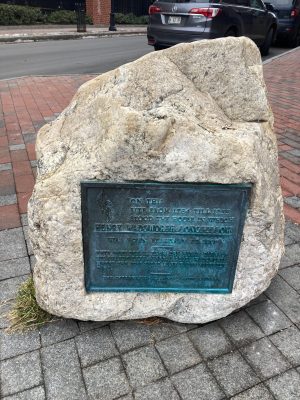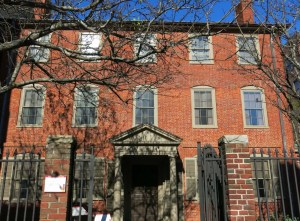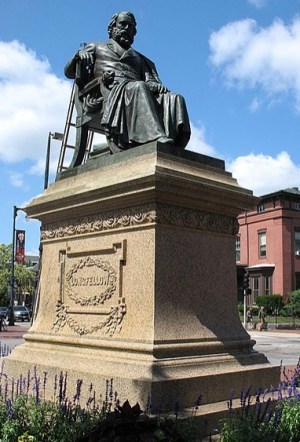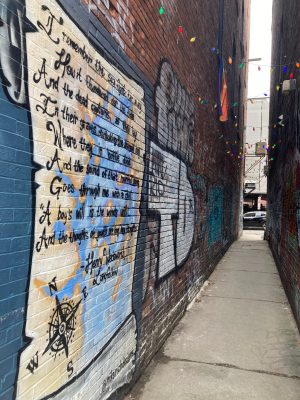The Longfellow Connection

You might be a poet and not even know it. Look at your feet. Are they long fellows?
Longfellow, the poet, is no stranger to Portland, Maine. He was born here in 1805, in room 346 of the Residence Inn on Fore Street. Well, okay maybe not, but the Longfellow home was where the Residence Inn is now located. Check out the big rock out front commemorating his birth here. It’s tough to read but remember it’s been there a long time, predating most of the buildings around it.


Who was Longfellow? In addition to being the patron saint of Portland, Henry Wadsworth Longfellow was easily the most important and famous American poet of the 19th century. Fans of Walt Whitman and Emily Dickinson might take issue with that, and while both were great poets, nobody has ever referred to either as “the American Shakespeare.” If Whitman and Dickinson are, respectively, the Eric Clapton and James Taylor of American letters in the 19th century, Longfellow is Elton John. His fame is worldwide, omnipresent, and ubiquitous. No word on his taste for platform shoes and diamond studded glasses.
Here in Portland, we have some serious Longfellow cred. Start with the Residence Inn and work your way over to Longfellow House. Property of the Mane Historical Society, this little brick house is a jewel in the landscape of American museums. Longfellow grew up here. It was his base of operations throughout his life. It is perfectly preserved; virtually everything in the house once belonged to the Longfellow family. Walk through the iron gate, into the house, and out to the beautiful, quiet garden out back, and time stops.

A block down the street down at Portland’s oldest church, First Parish, you can view the Longfellow’s family pew and the family’s iron foot warmer. A few more blocks the other way and there’s the man himself resting in a chair looking out over the lights and traffic of Longfellow Square. Maybe he’s contemplating life but I like to think he’s trying to decide on Thai or Mexican because the restaurants are so good around the Square. I’d say Thai for him as Mexican could get a little gnarly with the long beard he is famous for sporting.

Next, you could go looking for his dead relatives in two historic graveyards downtown or you could go check out Blythe and Burrows on Exchange, a great place to get a drink, and home to a poem on the side of their building about Blythe and Burrows, two navel sea captains who fought a fatal battle right off the coast here in 1813. The stanza is part of a longer poem that Longfellow wrote about his memory of that day, and his childhood here in Portland, Maine. It starts, “I often think of that beautiful city by the sea” and concludes, movingly, “A boy’s will is the wind’s will, and the thoughts of youth are long long thoughts.”

Hey, that sort of stuff could inspire you to write your own poem:
Longfellow was born at the Residence Inn
It could have been a Marriot.
He became a great poet anyway.
So I’m not sure we should care a lot.
Join us at Maine Day Ventures for our daily walk through time and you, too, can discover the nooks & crannies of the Old Port in Portland, ME.
Written by Portland Tour Guide – Ross

Referred to by his family as a “fuzzy foreigner”, Ross grew up in Nova Scotia, Canada, fell in love with a woman from Boston, and has been in Maine raising his family for over 20 years now. He loves Maine and loves his job as a tour guide, both for the interaction with new people it affords him (don’t be surprised to get as many questions as you ask) and the constant exploration he is always making of the many intricate and fascinating links between his adopted state and his homeland. He also loves the hard questions that he gets from his guests that lead him to learn new things. He sings every chance he gets during his tours (jury is still out whether that’s a good thing or not). When he’s not on a tour and it’s not snowy enough for skiing, he can usually be found somewhere in the state neck-deep in the ocean or a lake. In this he considers himself like every other Mainer- the cold water doesn’t bother him, and you’ll find him in shorts well into the winters.
When asked who he would be if he could be anyone in the history of Maine, Ross chose James Bacon Curtis, a peculiar Maine figure who made a million bucks with America’s first chewing gum factory, which was located in the Hub Furniture Store across from Fore-Street Restaurant. Anybody can make money, but how many people invent chewing gum?!
